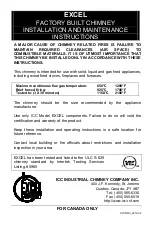
TB4, TB4MM, CS700, and CS700H Tipping Bucket Rain Gages
15
5.
0=snow sensor disabled; 1=snow sensor enabled
6.
0=heater elements off; 1=heater elements on
7.
0=automatic control; 1=manual control
8.
0=cycle disabled; 1=cycle enabled
9.
Low Power Heater cycle time left (mins)
When using an
M!
command, the data logger waits for the time specified by
the sensor, sends the
D!
command, pauses its operation, and waits until either it
receives the data from the sensor or the sensor timeout expires. If the data
logger receives no response, it will send the command a total of three times,
with three retries for each attempt, or until a response is received. Because of
the delays this command requires, it is only recommended in measurement
scans of 10 seconds or more or use
SlowSequence
.
A
C!
command follows the same pattern as an
M!
command with the
exception that it does not require the data logger to pause its operation until the
values are ready. Rather, the data logger picks up the data with the
D!
command on the next pass through the program. Another measurement request
is then sent so that data is ready on the next scan. To use this command, the
scan interval should be 10 seconds or less.
An
R!
command switches the sensor to automatically make measurements and
send data every 11 seconds, ±2 seconds, based on the sensor internal clock. If
measurements are requested at 2 seconds or faster, the sensor will increase its
measurement rate to approximately every 5 seconds. This instruction usually
takes less than 300 milliseconds to execute. The automatic measurement mode
can only be cancelled by powering down the sensor to reset it.
The CS700H also uses extended commands (X) to control the heater and
change settings. Appendix
(p. C-5)
, describes the
extended commands and provides detailed information about the SDI-12
interface. Additional SDI—12 information is also available at
or
www.youtube.com/user/CampbellScientific
9. Troubleshooting and Maintenance
All factory repairs and recalibrations require a returned material
authorization (RMA) and completion of the “Declaration of
Hazardous Material and Decontamination” form. Refer to the
page at the beginning of this manual for more
information.
9.1 Troubleshooting
Symptom: No Precipitation Measurement
1.
Check that the sensor is wired to the pulse or control terminal
specified by the pulse count instruction.
2.
Verify that the
PConfig
, and
Multiplier
and
Offset
parameters for the
PulseCount()
instruction are correct for the data logger type.
3.
Disconnect the sensor from the data logger and use an ohm meter to
do a continuity check of the switch. The resistance measured at the
terminal block on the inside of the bucket between the black and white
NOTE
















































